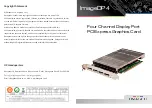
3
2.2 Driver Installation
Normally the driver will be automatically installed on Windows OS when the card is
installed, and user can use it without further operation. Suppose that driver is not installed
automatically, please do that with the provided CD, or you can download driver from our
official site http://www.inateck.com/support
Note
Please make sure the hardware (card) is installed before installing the driver.
Once you have finished installing the drivers, you must restart your computer.
Chapter 3: Troubleshooting Tips
• If the card or devices connected to the computer do not seem to be working properly,
please perform the following basic troubleshooting steps:
1. Check that all cables are securely connected in the proper places.
2. Make sure the USB device’s power is turned on.
3. Make sure the PCI-E card is properly installed and is connected to power.
4. Make sure there is no problem with the card installation.
• If your computer fails to start after installing the USB 3.1 PCI-E card:
1. Turn off the computer, remove the USB 3.1 PCI-E card, and try restarting the computer.
2. If the computer starts successfully, it means the card is not inserted into the PCI-E slot
correctly. Please clean the golden PCI-E connector on the card using a soft brush, soft
rubber, or a cotton swab. If this does not resolve the issue, try changing to a different
PCI-E slot.
• Is it possible to connect current USB 3.0 or USB 2.0 devices to the USB 3.1 PCI-E card?
Yes. Devices will not obtain the USB 3.1 data transmission speeds but are fully compatible.






























